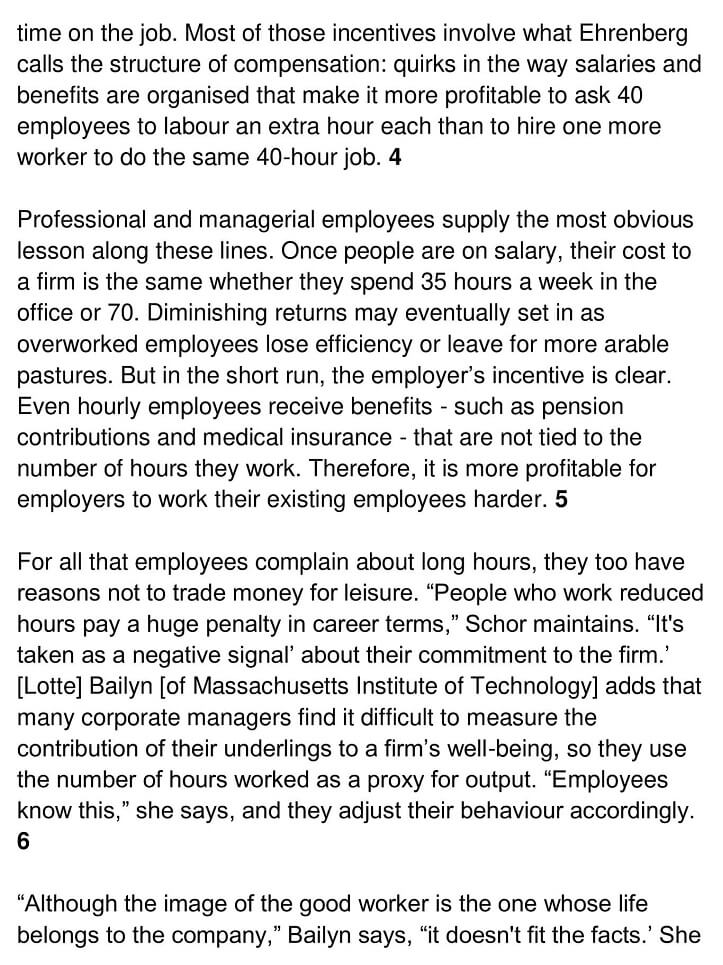A Workaholic Economy Reading Answers
Table of Contents
Limited-Time Offer : Access a FREE 10-Day IELTS Study Plan!
The Academic passage ‘A Workaholic Economy’ is a reading passage that appeared in an IELTS Test. Try to find the answers to get an idea of the difficulty level of the passages in the actual reading test. If you want more passages to solve, try taking one of our IELTS reading practice tests.
A Workaholic Economy





Answers
|
Question Number |
Answers | Explanation |
| 27 | NO | In paragraph 2, it is mentioned that although output per hour has been ‘more than doubled’ since 1945, ‘leisure seems reserved largely’. In fact, ‘working hours have increased noticeably since 1970’ because real wages have stagnated from that year’. Hence, the answer is no as the statement contradicts the writer. |
| 28 | NOT GIVEN | In the first paragraph, the only reference given to ‘social planners’ is when the writers tell that only a generation ago, they (social planners) were ‘worried about what people would do with all this new-found free time’ and it seems they ‘need not have bothered about the U.S.’. Hence, the answer is ‘not given’. |
| 29 | YES | In paragraph 2, the writer mentions that since 1970, the working hours have increased noticeably. The main reason for this change is that ‘real wages’ have ‘stagnated’ (not risen significantly) since that year (1970). Hence, the answer is yes. as the statement agrees with the writer. |
Unlock Answers
| 30 | NO | In paragraph 3, the writer states that the ‘current economic recovery’ has become infamous (‘has gained a certain amount of notoriety’) for ‘it’s “jobless” nature’. It may be added that increased production had almost entirely ‘decoupled from employment’. Hence, the answer is no as the statement contradicts the writer. |
| 31 | YES | In paragraph 7, the writer states that Bailey cites both ‘quantitative and qualitative studies’ (research) show ‘increased productivity’ (work more efficiently) of ‘part-time workers’. She adds that they (part-time workers) ‘make better use of time they have and are less likely to succumb to fatigue in stressful jobs’. Hence, the answer is yes. as the statement agrees with the writer. |
| 32 | NOT GIVEN | The only reference to ‘two-career households’ in this passage is given in paragraph 9. Here, the writer says that ‘U.S. market for goods had become skewed by the assumption of full-time, two-career households’. In this sentence, no reference to ‘leisure time’ is given. Hence, the answer is ‘not given’. |
| 33 | C | In paragraph 7, Bailyn asserts that ‘extra people’ (employ more workers) ‘can cover’ (substitute) the ‘contingencies’ (absent staff) going to happen, ‘such as when crises take people away from the workplace’. Hence, the answer is option C. |
| 34 | A | In paragraph 9, the writer has added Scor’s view that the U.S. market has become biased (‘skewed’) by the assumption of ‘full-time, two-career households’ which means longer ‘working hours’ or no reduction in the working hours. Otherwise they will not be able to afford cars (‘Automobile makers no longer manufacture cheap models’) or homes (‘developers do not build the tiny bungalows that served the first postwar generation of home buyers’). Hence, the answer is option A. |
| 35 | B(Extra work is offered to existing employees.) | In the first sentence of paragraph 4, it is mentioned that due to ‘a host of factors’ the employers hire fewer workers for more hours (extra work) and at the same time, compels ‘workers’ (existing employees) to ‘spend more time on the job’ (extra work). Therefore, option B is one of the factors that have resulted in employees working for longer hours. |
| 36 | D(Benefits and hours spent on the job are not linked) | In the fifth sentence of paragraph 5, the writer states that even hourly employees earn ‘benefits’ such as ‘pension contributions and medical insurance’. , But these benefits are ‘not tied’ (not linked) ‘to the number of hours’ the employees work. So, it is ‘more profitable’ for employers to ‘work their existing employees more’. Therefore, option D is one of the factors that have resulted in employees working for longer hours. |
| 37 | F(Longer hours indicate greater commitment to the firm) | In the second sentence of paragraph 6, it is said that according to Schor, people who work ‘reduced hours’ pay a ‘huge penalty in career terms’. This is because it is taken as a ‘negative signal’ about their ‘commitment to the firm’. So, if a worker works for ‘longer hours’ it shows ‘greater commitment’. Therefore, option F is one of the factors that have forced employees to work for longer hours. |
| 38 | G(Managers estimate staff productivity in terms of hours worked) | At the end of the sixth paragraph, Bailyn’s statement is given that many ‘corporate managers’ find it difficult to measure the contribution of their ‘underlings’ to the well being of their firm. So, they use ‘number of hours worked as a proxy’ for ‘output’ (productivity). She further adds in the next sentence that ‘employees know this…and they adjust their behaviour accordingly’. Therefore, option G is one of the factors that have resulted in employees to work for longer hours. |
Check More IELTS Reading Answers
Also check :
Practice IELTS Reading based on question types
Start Preparing for IELTS: Get Your 10-Day Study Plan Today!
Explore other Reading Topics

Janice Thompson

Kasturika Samanta
Recent Articles

Kasturika Samanta

Kasturika Samanta

Janice Thompson






Post your Comments